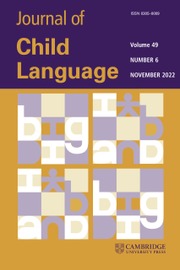Crossref Citations
This article has been cited by the following publications. This list is generated based on data provided by
Crossref.
Bar-Shalom, Eva
2002.
Tense and Aspect in Early Child Russian.
Language Acquisition,
Vol. 10,
Issue. 4,
p.
321.
O'Grady, William
2005.
How Children Learn Language.
van Hout, Angeliek
de Swart, Henriëtte
and
Verkuyl, Henk J.
2005.
Perspectives on Aspect.
Vol. 32,
Issue. ,
p.
1.
Shirai, Yasuhiro
and
Miyata, Susanne
2006.
Does past tense marking indicate the acquisition of the concept of temporal displacement in children's cognitive development?.
First Language,
Vol. 26,
Issue. 1,
p.
45.
Valian, Virginia
2006.
Young Children's Understanding of Present and Past Tense.
Language Learning and Development,
Vol. 2,
Issue. 4,
p.
251.
Green, Lisa
and
Roeper, Thomas
2007.
The Acquisition Path for Tense-Aspect: Remote Past and Habitual in Child African American English.
Language Acquisition,
Vol. 14,
Issue. 3,
p.
269.
Leonard, Laurence B.
Deevy, Patricia
Kurtz, Robert
Krantz Chorev, Laurie
Owen, Amanda
Polite, Elgustus
Elam, Diana
and
Finneran, Denise
2007.
Lexical Aspect and the Use of Verb Morphology by Children With Specific Language Impairment.
Journal of Speech, Language, and Hearing Research,
Vol. 50,
Issue. 3,
p.
759.
Becker, Misha
2007.
Comments from our Guest Editor.
Language Acquisition,
Vol. 14,
Issue. 3,
p.
219.
Kazanina, Nina
and
Phillips, Colin
2007.
A developmental perspective on the Imperfective Paradox.
Cognition,
Vol. 105,
Issue. 1,
p.
65.
Tomasello, Michael
2007.
Handbook of Child Psychology.
McCormack, Teresa
and
Hoerl, Christoph
2008.
Temporal Decentering and the Development of Temporal Concepts.
Language Learning,
Vol. 58,
Issue. s1,
p.
89.
Hoerl, Christoph
2008.
On being stuck in time.
Phenomenology and the Cognitive Sciences,
Vol. 7,
Issue. 4,
p.
485.
Leonard, Laurence B.
2009.
Is Expressive Language Disorder an Accurate Diagnostic Category?.
American Journal of Speech-Language Pathology,
Vol. 18,
Issue. 2,
p.
115.
2009.
REFERENCES.
Monographs of the Society for Research in Child Development,
Vol. 74,
Issue. 2,
p.
105.
Wagner, Laura
Swensen, Lauren D.
and
Naigles, Letitia R.
2009.
Children's early productivity with verbal morphology.
Cognitive Development,
Vol. 24,
Issue. 3,
p.
223.
Wagner, Laura
2009.
I'll never grow up: continuity in aspect representations.
Linguistics,
Vol. 47,
Issue. 5,
CHEN, JIDONG
and
SHIRAI, YASUHIRO
2010.
The development of aspectual marking in child Mandarin Chinese.
Applied Psycholinguistics,
Vol. 31,
Issue. 1,
p.
1.
Wagner, Laura
2010.
The acquisition of semantics.
WIREs Cognitive Science,
Vol. 1,
Issue. 4,
p.
519.
Shirai, Yasuhiro
2010.
Semantic bias and morphological regularity in the acquisition of tense-aspect morphology: what is the relation?.
Linguistics,
Vol. 48,
Issue. 1,
LEONARD, LAURENCE B.
and
DEEVY, PATRICIA
2010.
Tense and aspect in sentence interpretation by children with specific language impairment.
Journal of Child Language,
Vol. 37,
Issue. 2,
p.
395.

